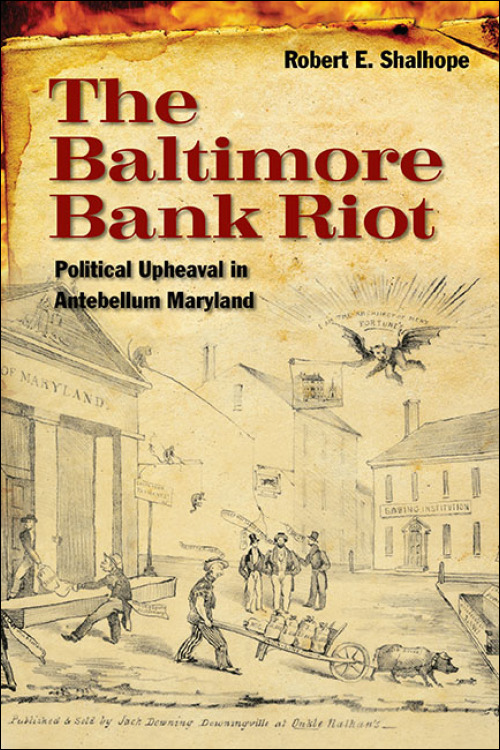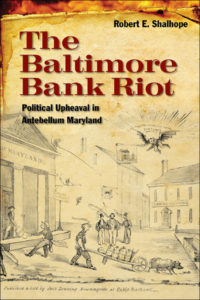Money Matters

In a three-day period in August 1835, Baltimoreans engaged in a tumultuous riot that killed five people, injured twenty others, and caused extensive property damage. As Americans slowly climb out of the Great Recession, the Baltimore Bank Riots remind us of the deep historical roots of Americans’ animosity toward banks. Historian Robert Shalhope, who has written numerous books and articles on Jeffersonian republicanism, the Second Amendment, and Jacksonian party development, provides a persuasive account of one of the most influential political events of the antebellum era. Shalhope’s monograph joins other recent books by Richard Kilbourne Jr., Stephen Mihm, and Richard Ellis, all of which portray the seamier elements of antebellum banking. Overspeculation, excessive leveraging, and fraudulent pyramid schemes—all of which have been blamed for our current financial crisis—were alive and well in the 1830s. As Shalhope explains, The Baltimore Bank Riot is a morality tale where “good people suffer at the hands of scoundrels whom they believe to be good people” (12).
With thousands of investors bankrupt, including many who lost their entire life’s savings, public outrage boiled over.
With a close reading of Baltimore’s leading newspapers, combined with political cartoons, broadsides, legislative committee reports, obscure pamphlets, and intimate knowledge of the existing historical literature, Shalhope argues that the riot stemmed from three principal causes: general anti-bank sentiment, a belief in popular sovereignty, and growing outrage over the frauds associated with the closing of the Bank of Maryland (2-3). The questions raised by the riot and its legal aftermath helped transform political parties in Maryland from loose factions centered around personalities to a diametrically polarized two-party system.
As the two parties developed coherent ideologies, they responded to local conditions in Maryland and adopted contrasting interpretations of popular sovereignty and the legacy of the American Revolution. Jacksonian Democrats, hailing the Lockean social contract and the political philosophy of Thomas Jefferson, embraced the people’s right to revolt. They “envisioned an egalitarian, democratic society” and believed that government should be continually responsive to the people (4). Whigs, on the other hand, emphasized social stability and favored a market-oriented society. One needed law and order to protect republican institutions from tyranny (116). Only a powerful state with strong institutions could protect private property, which, in turn, secured investment, commerce, and prosperity. These ideological differences shaped Maryland politics for the next thirty years, particularly during a state constitutional crisis in 1836 and Maryland’s flirtation with secession in 1860.
Shalhope begins by discussing the origins of Maryland’s anti-bank sentiment with particular attention to how the Bank of Maryland’s directors engaged in shady financial schemes. The bank’s main directors—Evan Poultney, Hugh McElderry, David Perine, John Glenn, and Reverdy Johnson—organized a “club” where they could embezzle customers’ deposits to pay for Bank of Maryland stock at inflated rates (33). The club then used this stock as collateral to invest in the newly created General Insurance Company. In addition, club members opened up numerous branches of the Bank of Maryland in several states and speculated in $500,000 worth of Tennessee state bonds. As homeowners today ruefully realize, this type of risky leveraging works so long as the underlying capital continues to appreciate. But when the Second Bank of the United States restricted credit in late 1833, forcing smaller banks to call in loans, the Bank of Maryland quickly became insolvent. The financial house of cards collapsed.
With thousands of investors bankrupt, including many who lost their entire life’s savings, public outrage boiled over. During the three days of rioting, angry mobs ransacked houses, lit bonfires in streets to destroy expensive furniture, and fueled further frenzy by consuming copious amounts of fine wine. On the third day of rioting, a counteroffensive led by General Samuel Smith quieted the flames. While prosecutors achieved convictions for a few of the mob’s leaders, the trials for the bank’s directors had more far-reaching consequences. These trials ignited fierce political debates between popular sovereignty on the one hand, and social stability on the other.
The Baltimore Bank Riot should appeal to both academics and laypeople alike. By qualifying his theoretical assumptions up front, Shalhope strengthens his intellectual credibility. He emphasizes language and ideology in party development, but stresses that his model applies only to Maryland. Moreover, Shalhope recognizes that republicanism and the market revolution—historically, two popular, though dichotomous, analytical paradigms that describe the antebellum era—do not suffice to explain local political complexities. For instance, both parties held a variety of views on national economic issues such as tariffs, internal improvements, banks, and land sales (9). The book’s prose is also highly readable, and Shalhope does not burden the reader with esoteric jargon.
Readers should pay close attention to Shalhope’s methodology, particularly his nuanced portrayal of social relations. No substantial differences in wealth existed between Democratic and Whig Party leaders, leading Shalhope to conclude that the “search for meaning in the language and ideas … takes on even greater significance,” and that public literature “is essential to any attempt to analyze the emergence of political and social persuasions” (3-4). Careful not to dismiss socio-economic conditions or take language at face value, the author, nonetheless, finds that the rioters’ behavior is best explained by the language, ideas, and discourse available to them through public literature.
Baltimoreans in the 1830s, he says, may have been aware of class distinctions, but they were not class conscious. Rioters did not target wealthy individuals across the board, but only those who were involved in the bank scandal (61). Yet it is clear that one’s social standing mattered a great deal in Shalhope’s narrative. Jacksonian editorials constantly derided Whigs as “monied aristocrats.” In some trials, the testimony of a “gentleman” was enough to jail some suspects without substantive evidence (76-77). The trials, moreover, reflected a concerted effort on the part of Baltimore’s gentry to reassert their power, prestige, and respectability. While there are subtle differences between privilege and class, authors from a different methodological persuasion might look at the same evidence and reach different conclusions. Shalhope correctly points out that Maryland’s Democrats were not anti-capitalist; they only “wanted the market open to all so that they, too, could prosper” (7). Touting the banner of equal rights, Jacksonians rejected corporate monopolies that afforded economic opportunity to a privileged few. But at other times, Shalhope says that Jacksonians held “traditional,” “communal” values and were, perhaps, even pre-modern (3). The evidence Shalhope presents for this characterization is sparse and he could have more clearly defined the terms traditional and modern.
Shalhope, perhaps, overstates his characterization of public opinion by relying heavily on anonymous pseudonyms from newspaper editorials. He argues that anti-bank language from Niles’ Register and the Baltimore Republican fueled visceral anger among many Baltimoreans (26) and that editorials in the aftermath of the trials had a strong influence on public opinion (94-96). While newspaper readership was high, proving this direct causal link is difficult. To his credit, Shalhope also analyzes bank-related public meetings, citizens’ memorials, and other literary devices of political culture. But he does not explore precisely why antebellum newspapers used anonymous pseudonyms and engaged in such vituperative rhetoric. This was, after all, the era of the party press, and newspapers were the key mechanism that connected party leaders with average voters. Editors also had a monetary incentive to publish violent language. Their success was not only dependent on increasing voter turnout, higher subscription rates, and building a party structure, but newspaper editors, through financial necessity, had to seek out political patronage and printing contracts. Publishing extreme commentary could help achieve this objective. Furthermore, pseudonyms such as “A Creditor” and “Junius” were often, in fact, masking editors or elite politicians, not subscribers. In doing so, editors created the illusion of public support for their views and purported to speak for public opinion. In the absence of reliable polling, public sentiment in the antebellum era is difficult to gauge.
The book’s concluding chapter may raise issues for historians of the Civil War. Between 1838 and 1860, slavery, immigration, class animosities, and debates over popular sovereignty in the western territories reconfigured the two-party system, with large slaveholders gravitating toward the Democratic Party (158-159). Yet Shalhope also claims that the “dramatically restructured Democratic Party espoused the same principles presented so forcefully by Samuel Harker and his fellow Democrats during the fall elections of 1836” and that the debate over secession in Maryland “rested upon precisely the same ideological beliefs that sustained the Whig and Democratic persuasions of 1836” (160-161). Drawing a parallel between calls for secession and earlier Jacksonian appeals to popular sovereignty is problematic. The author also indicates his sympathies when he says that with secession repulsed, “popular sovereignty had truly become a political fiction” (163). Throughout the book, Shalhope seems to lament the failure of Democratic appeals to the social contract, as well as the increasing power of state authority promoted by Whigs.
All things considered, however, the book is a must-read. Not beholden exclusively to the back-room wheeling-and-dealing of elite politics, nor the quotidian qualities of daily life, Shalhope successfully integrates political, intellectual, and social history. His chapter on the riot is especially exciting, giving readers a sense of the grass-roots political activism that pervaded antebellum America.
This article originally appeared in issue 11.2.5 (March, 2011).
Stephen Campbell is a Ph.D. candidate in the department of history at the University of California, Santa Barbara, and author of “Hickory Wind: The Role of Personality and the Press in Andrew Jackson’s Bank War in Missouri, 1831-1837,” Missouri Historical Review (2007). His dissertation project analyzes Andrew Jackson’s Bank War with special attention to newspaper editors, political patronage, and bank loans.
